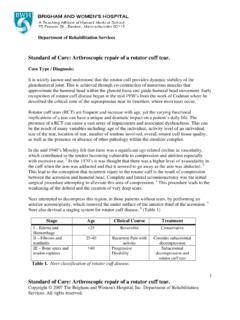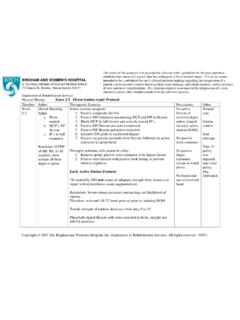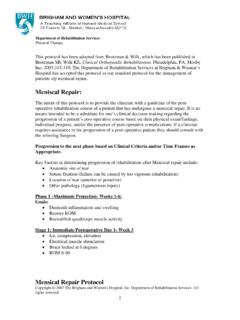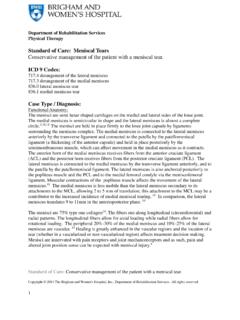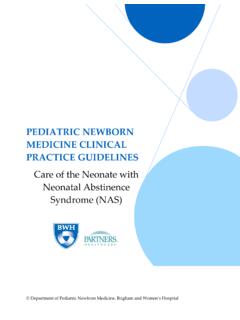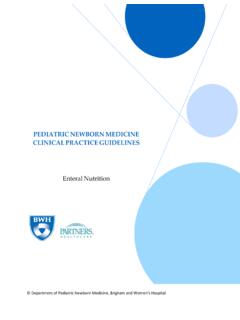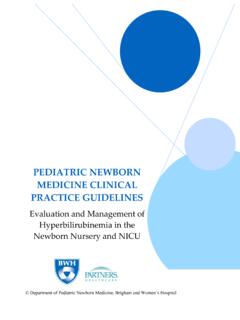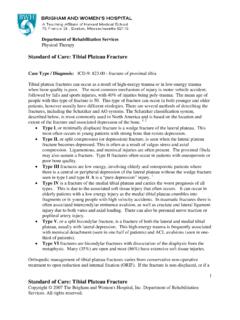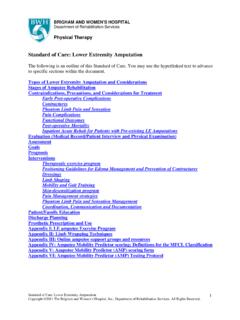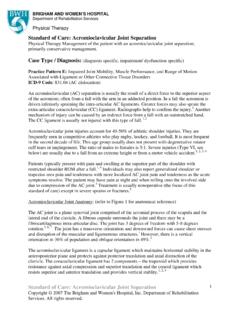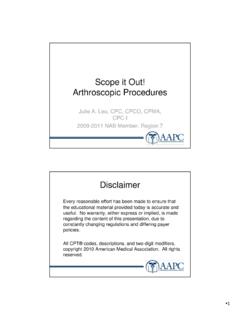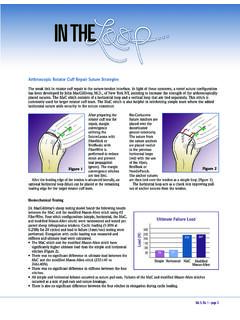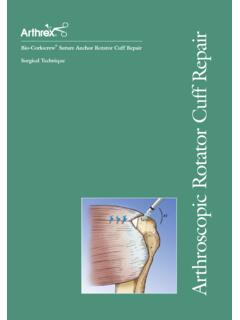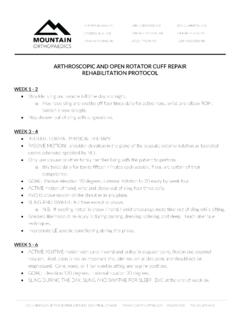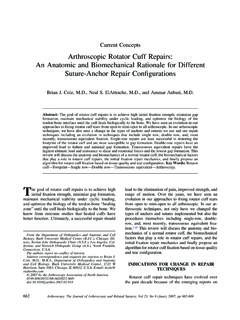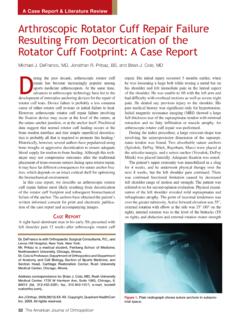Transcription of Arthroscopic Rotator Cuff Repair Frequently Asked Questions
1 Arthroscopic Rotator cuff Repair Protocol: Copyright 2016 The Brigham and Women's Hospital, Inc. Department of Rehabilitation Services. All rights reserved. 1 Arthroscopic Rotator cuff Repair Frequently Asked Questions : Are there differences between an Arthroscopic and open Rotator cuff Repair ? While the incision sites look smaller with an Arthroscopic procedure, it is important to remember that the same tissues were still repaired and thus the same post-operative precautions regarding tissue-healing time for repaired muscle/tendon are observed. Are there any patients that should be considered for an early range of motion postop operative rehab course? Many Surgeons may choose to have patients that have the following clinical situations start PT and ROM sooner to avoid the potential for post operative stiffness.
2 - Coexisting calcific tendonitis - Coexisting adhesive capsulitis - PASTA tears - Concomitant labral Repair - Acute single tendon cuff Repair Denard et al. Arthroscopy 2011. Huberty et al. Arthroscopy 2009. Koo et al. Arthroscopy 2011. Oh et al. Arthroscopy 2008. - Stiffness risk minimized with early protected external rotation and an unweighted slide into forward elevation. How should I manage my surgical site, dressing and steri-strips? Change your dressing every other day as needed. Allow the steri-strips to fall off on their own. If necessary, sutures will be removed at your first post-operative visit. You may shower with a watertight bandage in two days, but keep the incisions dry until the sutures are removed in seven to ten days. Try not to let the direct spray of water from the showerhead hit the incision.
3 Department of Rehabilitation Services Physical Therapy Arthroscopic Rotator cuff Repair Protocol: Copyright 2016 The Brigham and Women's Hospital, Inc. Department of Rehabilitation Services. All rights reserved. 2 Do I need to wear a sling/immobilizer? If so, how long do I wear it and when can I take it off during the day? You will be instructed by your surgeon to wear your sling from four to six weeks depending upon the size of your tear and thus the extent of the Rotator cuff Repair , and the sling should be worn at all times. You may have a small foam cushion between your arm and your body. This should be left in place at all times while wearing the sling. While in the sling, the elbow should be bent at a right angle, and the hand should be level with your elbow or slightly higher.
4 The elbow should be resting slightly in front of your body. You may remove the sling for exercises as prescribed by the surgeon/therapist, icing, dressing, and showering. What are my precautions regarding movements and positions after surgery? What positions should I rest my arm in? What positions should I avoid? Do not actively move your arm away from your body for four to six weeks following surgery. In addition, do not lift any object even if you are just bending your elbow. Follow your surgeon/therapist s directions regarding rotating your forearm away from your body to protect repaired tendon and muscles. When lying on your back we recommend you put a towel roll under your elbow to support arm. Many patients find that lying on a 30 degree incline wedge in bed is more comfortable than lying flat.
5 Some patients find sleeping in a recliner more comfortable during the first few weeks after surgery. Initially after surgery you should not reach behind your back with your operated arm. May I use my involved arm for dressing, bathing, driving, and other daily activities? How should I manage my arm in the shower? You may use your wrist, hand, and elbow for daily activities. This includes eating, shaving, dressing, as long as you do not move your operated arm away from your body and it does not increase your pain. Do not use your arm to push up/off the bed or chair for six weeks after your surgery. When using your keyboard and mouse, do not move your arm away from your body. Arthroscopic Rotator cuff Repair Protocol: Copyright 2016 The Brigham and Women's Hospital, Inc. Department of Rehabilitation Services.
6 All rights reserved. 3 When showering, you may wash under the involved arm pit by bending forward to let the involved arm hang freely and reaching under with the opposite arm Do not actively move your arm away from your body. When should I begin formal physical therapy? How often do I need to go? Physical therapy can usually be initiated within the first six weeks following surgery and your surgeon will refer you when the time is appropriate. This includes physical therapy sessions at the clinic, in addition to a home exercise program for range of motion and postural exercises. You will eventually be prescribed strengthening exercises. For very large tears, physical therapy may be delayed to promote Rotator cuff healing up to 6 weeks postoperatively. Frequency of treatment will be determined by your specific needs together with the physician and physical therapist recommendations.
7 When may I start strengthening? Typically, strengthening does not begin until twelve weeks after surgery. Are there any medications that I should not take during my recovery/rehabilitation? You should not take any anti-inflammatory (alleve, ibuprofen, and naproxen) medications for at least 12 weeks after surgery as may interfere with tendon healing. You can take Tylenol or any of the pain mediations your surgeon prescribes. In addition, the use of frequent (3-4 times per day) icing of your shoulder will assist in pain management. When may I return to sports and recreational activities? Return to sports and recreational activities are specific to the particular activity, but generally no sooner than four to six months. Always seek permission from your surgeon and therapist prior to starting any sports related activity.
8 Can I smoke following surgery? You should not smoke after surgery as it interferes with tendon healing. Arthroscopic Rotator cuff Repair Protocol: Copyright 2016 The Brigham and Women's Hospital, Inc. Department of Rehabilitation Services. All rights reserved. 4 Will I progress just like my friend who had Rotator cuff Repair surgery? There are many patient specific variables that impact everyone differently. Hence, your recovery is individually based not only on tear size and tissue quality but also on a bell-shaped curve (see below) which takes into account function, relief of pain, and recovery of power. Typically it will be at least 6 months before you feel real good and you are ready to return to pre injury/surgery activities. Some individuals take up to 1 year before they fully recover. Arthroscopic Rotator cuff Repair Protocol: Copyright 2016 The Brigham and Women's Hospital, Inc.
9 Department of Rehabilitation Services. All rights reserved. 5 Decision Making Algorithm for the treatment of a Patient following Arthroscopic Rotator cuff Repair . Please see separate document. Arthroscopic Rotator cuff Repair Protocol: Copyright 2016 The Brigham and Women's Hospital, Inc. Department of Rehabilitation Services. All rights reserved. 6 Arthroscopic Rotator cuff Repair Protocol: Copyright 2016 The Brigham and Women's Hospital, Inc. Department of Rehabilitation Services. All rights reserved. 7 Algorithm from: Thigpen, CharlesA., Shaffer, Michael A., Gaunt, Bryce W., Leggin, Brian G., Williams, Gerald R., Wilcox, Reg B. The American Society of Shoulder and Elbow Therapists consensus statement on rehabilitation following Arthroscopic Rotator cuff Repair . Journal of Shoulder and Elbow Surgery.
10 2016; 4: 521-535. Arthroscopic Rotator cuff Repair Protocol: Copyright 2016 The Brigham and Women's Hospital, Inc. Department of Rehabilitation Services. All rights reserved. 8 Arthroscopic Rotator cuff Repair Postoperative Guidelines: The intent of this guideline is to provide both the patient and treating therapist with a framework of the post-operative rehabilitation course following Arthroscopic assisted/mini-open Rotator cuff Repair . It is by no means intended to be a substitute for one s clinical decision making regarding the progression of a patient s post-operative course based on their physical exam/findings, individual progress, and/or the presence of post-operative complications. If a therapist requires assistance in the progression of a post-operative patient they should consult with the referring Surgeon.
